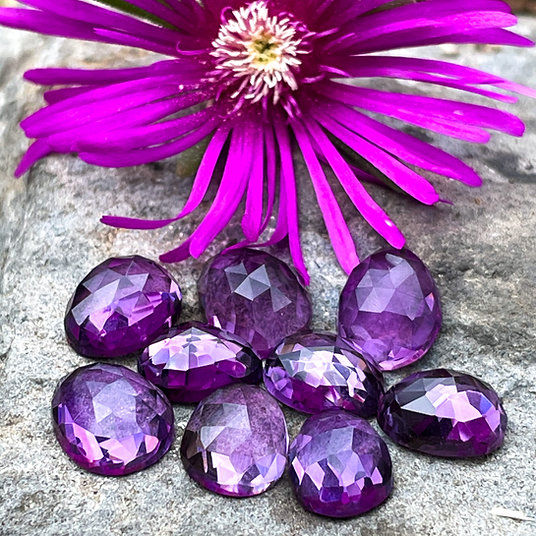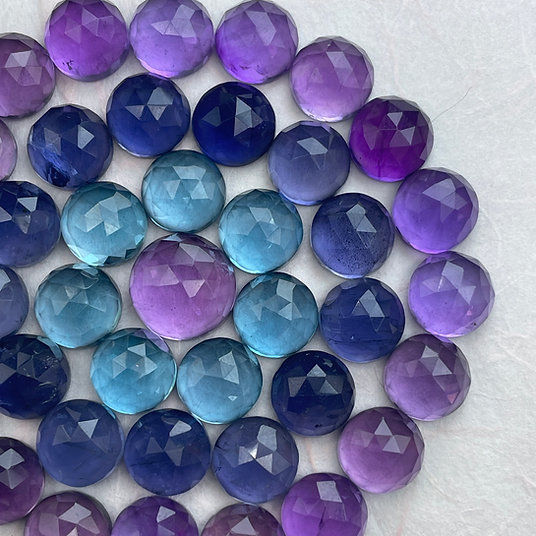Amethyst is the February birthstone, and the zodiac stone for those born under the sign of Pisces. It is also appropriate for celebrating 6th wedding anniversaries.
Amethyst is a stone that has long been loved by royalty, and today is a versatile stone for metalsmiths and artisan jewelers.
In this metalsmith’s guide to Amethyst, we’ll explore its unique color, where it can be found in nature, its historical use, metaphysical meaning and tips for designing jewelry with it.
WHAT COLORS DO AMETHYSTS COME IN?
Amethyst, by definition, is purple. It is so distinguishable that ‘amethyst’ is now the name of a color as well as the name of a gemstone.
But in that beautiful color are variations ranging from light to dark purple, and reddish to violet purple. While the intense and uniform saturation of purple is the most common in the stones you’ll find, amethyst gemstones may also show ‘color zoning’ – what Lucidity Gemstones refers to as ‘variegated’. How does this occur? To answer that question, let’s explore a little about how amethyst forms in nature.
Amethyst is a form of quartz, and iron is the agent that colors the stone. Amethyst crystals grow slowly inside rock cavities– so slowly that the concentrations of iron infiltrating the host rock may change over time, adding layers of crystal that have more or less iron content. As time goes on, radiation that is emitted from the surrounding host rock causes the iron to lose an electron, which changes the iron’s color to the familiar purple.
In crystals that had varying iron composition, this creates zones of different color intensity like growth rings on a tree. The most intense color is usually at the apex of the crystal, and is sometimes in a layer so thin that it is a challenge for stone cutters to obtain a uniform cut stone.
WHAT IS GREEN AMETHYST?
You may have heard of green amethyst? Well, technically, amethyst can NOT be green.
Remember that, by definition, amethyst is purple. But you’ll see the language ‘green amethyst’ to refer to prasiolite.
Prasiolite is a yellow-green to green variety of quartz. While some prasiolite is mined, much of it is produced by heating natural amethyst to about 500 degrees Celsius, which changes the amethyst's color from purple to its pale greenish tints. The name ‘prasiolite’ comes from two Greek words that define well the stone’s color: prason (leek) and lithos (stone).
Only a few amethyst localities in the world are known to have amethyst that converts to prasiolite, the most notable being the Montezuma deposit in Minas Gerais, Brazil.
WHAT IS AMETRINE?
Ametrine is a variety of bicolored quartz in which citrine and amethyst occur in contact with one another in a single crystal. Its composition gives the stone its compound name.
Ametrine’s natural occurrence as a commercial stone is limited to a mine in eastern Bolivia.
WHERE CAN AMETHYSTS BE FOUND?
Amethysts are mined in many places in the world, including the United States, where the Four Peaks Mine in Arizona produces a unique reddish-purple stone. That mine was known by Native Americans, because amethyst arrowheads were found nearby.

But by far, the majority of amethysts come from mines in southern Brazil and in neighboring Uruguay. There it is found in the cavities of basalt (think congealed lava) flows.
Large cavities can contain hundreds of pounds to several tons of amethyst crystals. Smaller cavities are known as geodes, and if you’ve been to gem and mineral shows, you’ve certainly seen amethyst geodes.
The large quantities of amethysts mined today make it an affordable stone for metalsmiths.
THE HISTORY OF AMETHYST JEWELRY
Amethysts acquired their name from stories of the Greek god of wine, Dionysus (Bacchus), who was given an amethyst to protect him from drunkenness. The Greek word amethystos means ‘not intoxicated’. It continued to have this association for millennia. Gradually this belief evolved to a broader association of amethyst with clear-headedness in business and battle.
"The stone is an amethyst; but I, the tipler Dionysus, say, 'Let it either persuade me to be sober, or let it learn to get drunk.'" – Plato the Younger
Amethyst jewelry has been found and dated as early as 2000 BC. The Egyptians mined amethyst in southern Egypt and carved it into amulets and religious items associated with their gods and afterlife.

Some historical accounts say that Saint Valentine had an amethyst ring carved with an image of Cupid, possibly the source of its status as the February birthstone. Its association with a happy love life predates St. Valentine. The Romans believed that women who wore amethyst would be better able to keep their husbands.
Amethyst was long held to be one of the most precious gemstones, on a par with diamonds, sapphires, rubies and emeralds, and often favored by royalty.
As far back as ancient Rome, only the nobility and the imperial court could “wear the purple” because of the cost of the dye. The color – and thus the gemstone - symbolized both power and responsibility. This extended to the clergy; only high-ranking clergy – bishops in particular – wore amethyst rings.

With amethyst mines found in Siberia, these stones were favorites of Russian royalty. Catherine the Great required them to be used in all her personal effects. They were also loved by the ill-fated Romanov imperial family of Russia, who commissioned Faberge to design pieces.
When the family was sent into exile after the Russian Revolution, Empress Alexandra smuggled a large array of the crown jewels out of their imprisonment and into the hands of nuns in a convent.
Among them were several pieces set with amethysts and diamonds. Sadly, the crown jewels were later discovered and confiscated by the Soviets, and their ultimate fate is not known.
WHAT DO AMETHYSTS SYMBOLIZE?
Leonardo da Vinci believed that amethyst helped to activate intelligence and get rid of evil thoughts, and the crystal still represents these characteristics today. It is considered a healing stone, protective against negative energies. Amethyst is said to dissipate rage, help manage fears, and calm anxiety. It enhances peacefulness and mental clarity.
The stone symbolizes purification, and it is associated with the spiritual or divine. It is even said that it promotes soothing dreams by connecting us with the divine. Serenity, grace, and understanding are its gifts. Tibetan Buddhists use amethyst beads in meditation.
As in ancient times, it is understood today to help with making better choices by granting intellectual clarity. But it also enhances intuition, giving rise to an association with creativity and imagination, making it a natural for all you artisan jewelry designers!
DESIGNING JEWELRY WITH AMETHYSTS
Amethyst is a versatile stone for artisan jewelers. Because of its availability, it is a modestly priced gemstone. Its hardness on the Mohs scale is 7, making it a good candidate for all types of jewelry because it does not scratch easily. And because of its beauty, it remains prized by customers.
Amethyst’s rich color invites it to be set alone, as the centerpiece of a ring or pendant. It also works well matched with colorless stones. The royals paired it with diamonds, but crystal quartz or cubic zirconia will also do nicely. Stones with iridescence also make great pairings with amethyst, as the iridescence sets off the amethyst’s color.
Opals and moonstone are especially good with amethyst, and pearls have long been a favorite match. If you want a double jolt of symbolism, moonstones have the same characteristics as amethysts of enhancing calm, clarity and intuition. Beware, however: some sources warn that combining stones in the quartz family with those associated with the moon can create dissonance in the energy exerted by the ‘competing’ stones.
When it comes to colored stones, amethysts create a striking contrast to turquoise and other blue and teal-colored stones, such as London blue topaz, iolite, grandidierite, or blue, teal moss or ocean kyanite. It also is dramatic when paired with the lime green of peridot. A more pastel but equally beautiful combination is amethyst with rose quartz.
Settings for amethysts are equally versatile. Both prong and bezel settings are attractive, though if you have a good faceted stone, you may want to use a setting that optimizes the light reaching it from all angles. Smooth amethyst cabochons work particularly well in earrings.
Amethyst is attractive for both silversmiths and goldsmiths, blending well with both gold and silver settings. Even rose gold sets off amethysts very well.
HANDLING AND CARE OF AMETHYSTS
In addition to its hardness, amethyst is a fairly durable stone, not particularly subject to fractures or chipping. Sudden temperature changes can, however, cause a fracture. But as suggested by the fact that heat treatment is used to create color changes in amethyst, amethysts shouldn’t be subjected to prolonged bright sunlight or other sources of UV light, as fading will occur over time. They are best stored in dark, dry places.
Cleaning of amethysts is best done with warm, soapy water (dish soap is appropriate).
Amethysts, with their clear, calming beauty and great versatility, make a prized stone for artisan jewelers!
Check out Lucidity’s complete Amethyst Collection for amethyst rose cuts and cabochons, as well as ametrine and prasiolite!










Comments